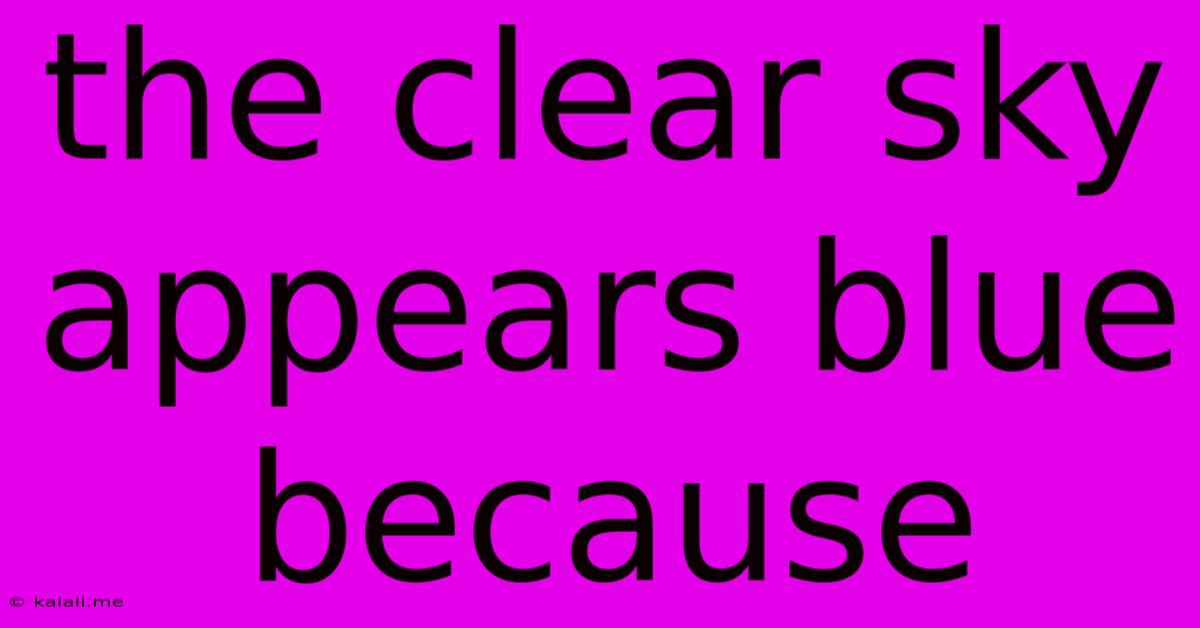The Clear Sky Appears Blue Because
Kalali
Jun 14, 2025 · 3 min read

Table of Contents
The Clear Sky Appears Blue: Unveiling the Science Behind the Color
Why is the sky blue? This seemingly simple question hides a fascinating explanation rooted in the physics of light and the composition of our atmosphere. Understanding this phenomenon requires exploring the concepts of scattering, wavelengths, and the role of air molecules. This article will delve into the science behind this everyday wonder, explaining why a clear sky appears blue and addressing some common misconceptions.
The primary reason the sky appears blue is due to a process called Rayleigh scattering. Sunlight, which appears white to us, is actually composed of all the colors of the rainbow. When sunlight enters the Earth's atmosphere, it collides with tiny air molecules, primarily nitrogen and oxygen. These molecules are much smaller than the wavelengths of visible light.
Rayleigh Scattering: The Key Player
Rayleigh scattering is the preferential scattering of shorter wavelengths of light by these small particles. Blue and violet light, having the shortest wavelengths in the visible spectrum, are scattered much more strongly than longer wavelengths like red and orange. This means that blue light is scattered in all directions, reaching our eyes from all parts of the sky.
Why Not Violet?
While violet light is scattered even more strongly than blue light, our eyes are less sensitive to violet, and the sun emits slightly less violet light than blue. Therefore, we perceive the sky as blue, rather than violet.
What About Sunsets and Sunrises?
The sky's color changes dramatically at sunrise and sunset. This is because the sunlight travels through a much longer path in the atmosphere at these times. The shorter wavelengths (blue and green) are scattered away over the longer distance, leaving the longer wavelengths (reds and oranges) to reach our eyes, creating the spectacular colors we witness.
Other Factors Influencing Sky Color
While Rayleigh scattering is the dominant factor, other phenomena can subtly affect the sky's appearance:
- Clouds: Clouds appear white because they are composed of larger water droplets that scatter all wavelengths of light equally, resulting in white light.
- Aerosols: Particles like dust and pollution can scatter light differently, leading to variations in the sky's color. Increased aerosols can lead to hazy or reddish skies.
- Altitude: The sky appears darker blue at higher altitudes because there are fewer air molecules to scatter the light.
- Atmospheric Conditions: Humidity and pressure can also influence light scattering and thus impact the perceived color of the sky.
Debunking Common Misconceptions:
- The sky isn't actually blue: The sky itself is colorless. The blue color we see is a result of the interaction of sunlight with the atmosphere.
- It's just reflection from the ocean: This is incorrect. While the ocean can reflect blue light, it's not the primary reason why the sky appears blue.
Understanding why the sky is blue involves a combination of physics and atmospheric science. By grasping the concepts of Rayleigh scattering and wavelength dependency, we can appreciate the intricate process that creates this breathtaking everyday phenomenon. The next time you look up at a clear blue sky, remember the fascinating science behind its stunning color.
Latest Posts
Latest Posts
-
Which Of The Following Is Not A Communication Style
Jun 15, 2025
-
Choose The Correct Statements About Dna Synthesis
Jun 15, 2025
-
Lcm Of 8 12 And 15
Jun 15, 2025
-
What Is The Lcm Of 3 8 And 12
Jun 15, 2025
-
Words To Describe A Great Mom
Jun 15, 2025
Related Post
Thank you for visiting our website which covers about The Clear Sky Appears Blue Because . We hope the information provided has been useful to you. Feel free to contact us if you have any questions or need further assistance. See you next time and don't miss to bookmark.